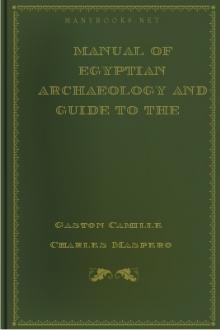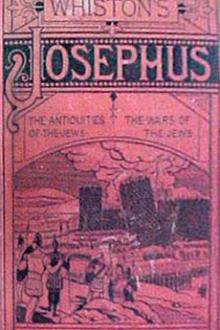Manual of Egyptian Archaeology and Guide to the Study of Antiquities in Egypt by Gaston Maspero (i have read the book txt) 📕

107. Wall-scene from temple of Denderah
108. Obelisk of Heliopolis, Twelfth Dynasty
109. Obelisk of Begig, Twelfth Dynasty
110. "Table of offerings" from Karnak
111. Limestone altar from Menshîyeh
112. Wooden naos, in Turin Museum
113. A mastaba
114. False door in mastaba
115. Plan of forecourt, mastaba of Kaäpir
116. Plan of forecourt, mastaba of Neferhotep
117. Door in mastaba façade
118. Portico and door of mastaba
119. Plan of chapel, mastaba of Khabiûsokari
120. Plan of chapel, mastaba of Ti
121. Plan of chapel, mastaba of Shepsesptah
122. Plan of chapel, mastaba of Affi
123. Plan of chapel, mastaba of Thenti
124. Plan of chapel, mastaba of Red Scribe
125. Plan of chapel, mastaba of Ptahhotep
126. Stela in mastaba of Merrûka
127. Wall-scene from mastaba of Ptahhotep
128. Wall-scene from mastaba of Ûrkhûû
129. Wall-scene from mastaba of Ptahhotep
130. Plan of serdab in mastaba at Gizeh
131. Plan of serdab and
Read free book «Manual of Egyptian Archaeology and Guide to the Study of Antiquities in Egypt by Gaston Maspero (i have read the book txt) 📕» - read online or download for free at americanlibrarybooks.com
- Author: Gaston Maspero
- Performer: -
Read book online «Manual of Egyptian Archaeology and Guide to the Study of Antiquities in Egypt by Gaston Maspero (i have read the book txt) 📕». Author - Gaston Maspero
Fig 262.--Mask of Twenty-first Dynasty coffin of Rameses II. Fig 262.--Mask of Twenty-first Dynasty coffin of Rameses II.
Among the sarcophagi belonging to kings of the Seventeenth Dynasty which I recovered from Deir el Baharî, the most highly finished belonged to this type, and were only remarkable for the really extraordinary skill with which the craftsman had reproduced the features of the deceased sovereigns. The mask of Ahmes I., that of Amenhotep I., and that of Thothmes II., are masterpieces in their way. The mask of Rameses II. shows no sign of paint, except a black line which accentuates the form of the eye. Fig 263.--Mask of Twenty-first Dynasty coffin of Rameses II. Fig 263.--Mask of Twenty-first Dynasty coffin of Rameses II.
The face is doubtless modelled in the likeness of the Pharaoh Herhor, who restored the funerary outfit of his puissant ancestor, and it will almost bear comparison with the best works of contemporary sculpture (fig. 262). Two mummy-cases found in the same place--namely, those of Queen Ahmesnefertari and her daughter, Aahhotep II.--are of gigantic size, and measure more than ten and a half feet in height (fig. 263). Standing upright, they might almost be taken for two of the caryatid statues from the first court at Medinet Habû, though on a smaller scale. The bodies are represented as bandaged, and but vaguely indicate the contours of the human form. The shoulders and bust of each are covered with a kind of network in relief, every mesh standing out in blue upon a yellow ground. The hands emerge from this mantle, are crossed upon the breast, and grasp the Ankh, or Tau-cross, symbolic of eternal life. The heads are portraits. The faces are round, the eyes large, the expression mild and characterless. Each is crowned with the flat-topped cap and lofty plumes of Amen or Maut. We cannot but wonder for what reason these huge receptacles were made. The two queens were small of stature, and their mummies--which were well-nigh lost in the cases--had to be packed round with an immense quantity of rags, to prevent them from shifting, and becoming injured. Apart from their abnormal size, these cases are characterised by the same simplicity which distinguishes other mummy-cases of royal or private persons of the same period. Towards the middle of the Nineteenth Dynasty, the fashion changed. The single mummy-case, soberly decorated, was superseded by two, three, and even four cases, fitting the one into the other, and covered with paintings and inscriptions. Sometimes the outer receptacle is a sarcophagus with convex lid and square ears, upon which the deceased is pictured over and over again upon a white ground, in adoration before the gods of the Osirian cycle. When, however, it is shaped in human form, it retains somewhat of the old simplicity. The face is painted; a collar is represented on the chest, a band of hieroglyphs extends down the whole length of the body to the feet, and the rest is in one uniform tone of black, brown, or dark yellow. The inner cases were extravagantly rich, the hands and faces being red, rose-coloured, or gilded; the jewellery painted, or sometimes imitated by means of small morsels of enamel encrusted in the wood-work; the surfaces frequently covered with many- coloured scenes and legends, and the whole heightened by means of the yellow varnish already mentioned. The lavish ornamentation of this period is in striking contrast with the sobriety of earlier times; but in order to grasp the reason of this change, one must go to Thebes, and visit the actual sepulchres of the dead. The kings and private persons of the great conquering dynasties[70] devoted their energies, and all the means at their disposal, to the excavation of catacombs. The walls of those catacombs were covered with sculptures and paintings. The sarcophagus was cut in one enormous block of granite or alabaster, and admirably wrought. It was therefore of little moment if the wooden coffin in which the mummy reposed were very simply decorated. But the Egyptians of the decadence, and their rulers, had not the wealth of Egypt and the spoils of neighbouring countries at command. They were poor; and the slenderness of their resources debarred them from great undertakings. They for the most part gave up the preparation of magnificent tombs, and employed such wealth as remained to them in the fabrication of fine mummy-cases carved in sycamore wood. The beauty of their coffins, therefore, but affords an additional proof of their weakness and poverty. When for a few centuries the Saïte princes had succeeded in re-establishing the prosperity of the country, stone sarcophagi came once more into requisition, and the wooden coffin reverted to somewhat of the simplicity of the great period. But this Renaissance was not destined to last.
Fig 264.--Panel portrait from the Graeco-Roman Cemetery at Hawara, now in the National Gallery, London. (Hawara, Biahmu, and Arsinoe, W.M.F. Petrie, Plate X., page 10.) Fig 264.--Panel portrait from the Graeco-Roman Cemetery at Hawara, now in the National Gallery, London. (Hawara, Biahmu, and Arsinoe, W.M.F. Petrie, Plate X., page 10.)
The Macedonian conquest brought back the same revolution in funerary fashions which followed the fall of the Ramessides, and double and triple mummy cases, over-painted and over-gilded, were again in demand. If the craftsmen of Graeco-Roman time who attired the dead of Ekhmîm for their last resting places were less skilful than those of earlier date, their bad taste was, at all events, not surpassed by the Theban coffin-makers who lived and worked under the latest princes of the royal line of Rameses.
A series of Graeco-Roman examples from the Fayûm exhibit the stages by which portraiture in the flat there replaced the modelled mask, until towards the middle of the second century A.D. it became customary to bandage over the face of the mummy a panel-portrait of the dead, as he was in life (fig. 264).
The remainder of the funerary outfit supplied the cabinet-maker with as much work as the coffin-maker. Boxes of various shapes and sizes were required for the wardrobe of the mummy, for his viscera, and for his funerary statuettes. He must also have tables for his meals; stools, chairs, a bed to lie upon, a boat and sledge to convey him to the tomb, and sometimes even a war-chariot and a carriage in which to take the air.[71] The boxes for canopic vases, funerary statuettes, and libation-vases, are divided in several compartments. A couchant jackal is sometimes placed on the top, and serves for a handle by which to take off the lid. Each box was provided with its own little sledge, upon which it was drawn in the funeral procession on the day of burial. Beds are not very uncommon. Many are identical in structure with the Nubian angarebs, and consist merely of some coarse fabric, or of interlaced strips of leather, stretched on a plain wooden frame. Few exceed fifty-six inches in length; the sleeper, therefore, could never lie outstretched, but must perforce assume a doubled-up position. The frame is generally horizontal, but sometimes it slopes slightly downwards from the head to the foot. It was often raised to a considerable height above the level of the floor, and a stool, or a little portable set of steps, was used in mounting it. These details were known to us by the wall-paintings only until I myself discovered two perfect specimens in 1884 and 1885; one at Thebes, in a tomb of the Thirteenth Dynasty, and the other at Ekhmîm, in the Graeco-Roman necropolis. In the former, two accommodating lions have elongated their bodies to form the framework, their heads doing duty for the head of the bed, and their tails being curled up under the feet of the sleeper.
The bed is surmounted by a kind of canopy, under which the mummy lay in state. Rhind had already found a similar canopy, which is now in the Museum of Edinburgh[72] (fig. 265). In shape it is a temple, the rounded roof being supported by elegant colonnettes of painted wood. A doorway guarded by serpents is supposed to give access to the miniature edifice. Three winged discs, each larger than the one below it, adorn three superimposed cornices above the door, the whole frontage being surmounted by a row of erect uraei, crowned with the solar disc. The canopy belonging to the Thirteenth Dynasty bed is much more simple, being a mere balustrade in cut and painted wood, in imitation of the water-plant pattern with which temple walls were decorated; the whole is crowned with an ordinary cornice. In the bed of Graeco-Roman date (fig. 266), carved and painted figures of the goddess Ma, sitting with her feather on her knee, are substituted for the customary balustrades.
Fig 266.--Canopied mummy-couch, Graeco-Roman. Fig 266.--Canopied mummy-couch, Graeco-Roman.
Isis and Nephthys stand with their winged arms outstretched at the head and foot. The roof is open, save for





Comments (0)